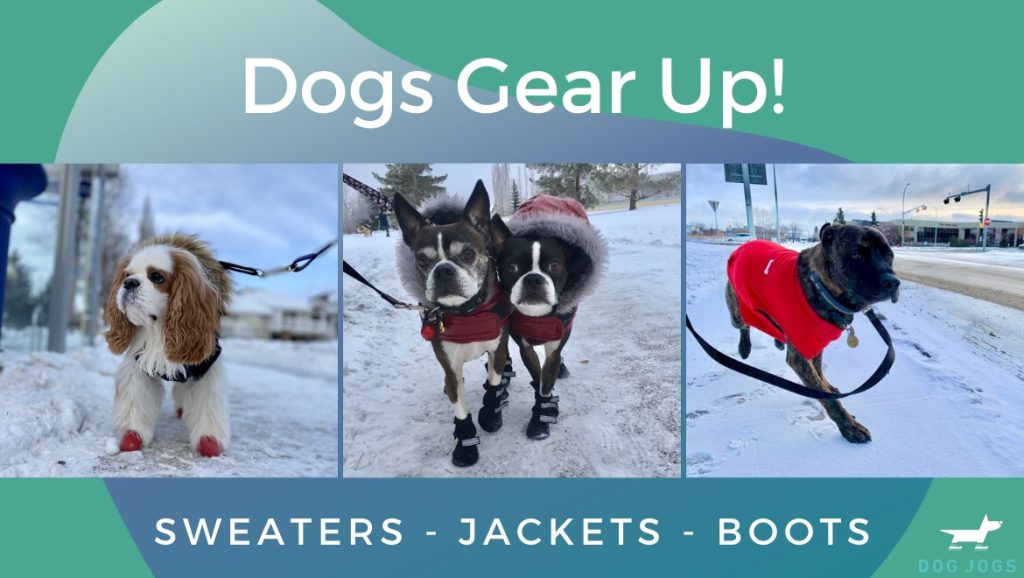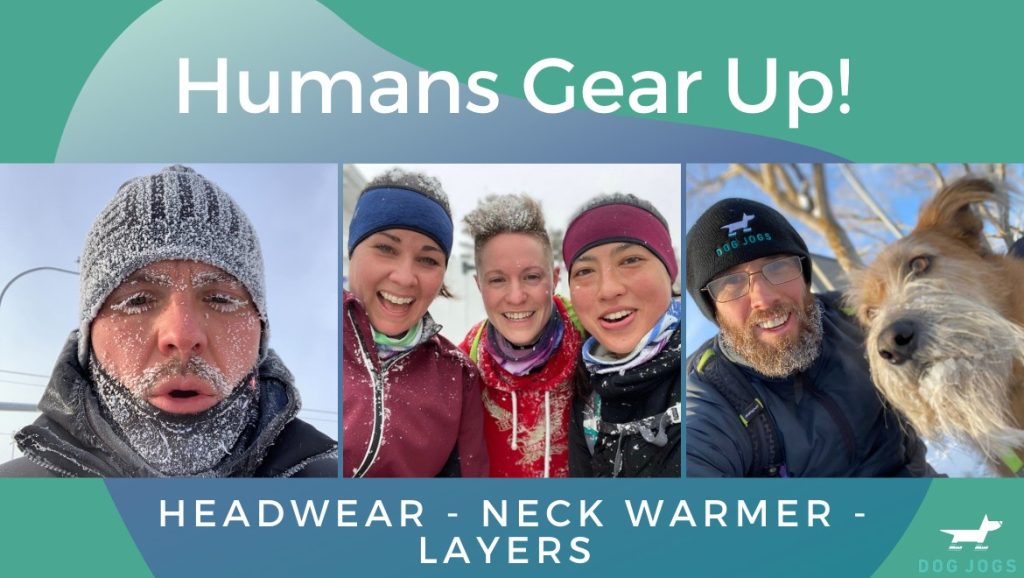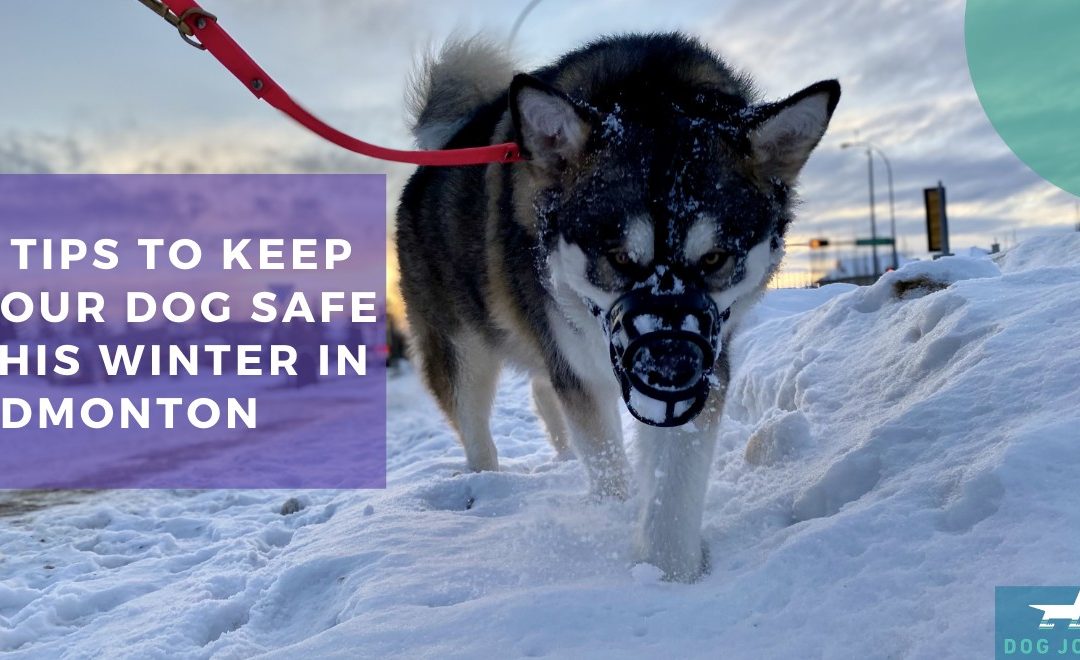As an Edmontonian, you are definitely familiar with the harsh winters we can face. And as a dog owner, you also know how challenging it can be to ensure your dog gets their daily exercise in while keeping them safe from the elements. In extreme cases, if exposed to the elements too long, your dog could suffer from frostbite and even hypothermia. As a dog walking and jogging company in Edmonton, we can tell you that it is possible to walk your dog in the winter, but there are some things you can do to ensure their safety.
What Gear Should Dogs Wear?
Dogs all come in different sizes and breeds with varying abilities to withstand colder temperatures. Dog breeds such as Huskies and Malamutes have thick double fur coats that help insulate them in the winter. Other dog breeds like Chihuahuas and Pitbulls aren’t quite as equipped to handle the cold. In general, a snug sweater or jacket is a winter essential for many of our furry friends. If the sweater is too loose, it allows the wind and cold to penetrate the layer, failing to keep the dog warm. Like humans, increasing layers and being thoughtful with certain fabrics like, fleece or a wind-breaker, can help your dog retain body heat. Some dogs may also benefit from wearing boots to protect their paws from ice and the cold. But winter gear can only go so far, shorter walks and more play indoors can be a better alternative when the temperature is extremely cold.

Edmonton pups wearing their winter jackets and boots
How Cold Is Too Cold?
As aforementioned, different dog breeds handle cold temperatures differently. However, all dogs face a risk to their safety when the temperatures are extremely cold. Many factors play a role in their ability to withstand the temperature. These factors include but are not limited to their breed, healthy, age, the gear they wear, and the duration of time they spend outside. It is always best to emphasize safety when going for walks or jogs with dogs. So before going for a walk, check the temperature, the windchill, gear them up properly, and keep an eye out for how long you spend in the cold. If your dog starts to get too cold, they will typically show signs that they need to warm up. Many dogs may lift their paws, whine, shiver, refuse to walk, and have cold extremities. Stay close to home so that you can head home quickly if you and your dog need to warm up.
Avoid Salt/Ice Melt
As dog walkers in Edmonton, we have seen dogs experience the negative effects of ice melt/salt in unavoidable situations. Some dogs are able to power through, other dogs limp/cry, and others just stop in their tracks. The granules are jagged and sharp, which can cut your dog’s paws. If the cuts are deep enough, the chemicals can dry out, irritate and even burn the tissues. Another great reason why boots are a good idea for your dog during the winter. However, if boots are not an option, it is always best to stay proactive and avoid sidewalks littered with melt. And as an extra precaution, it’s a good idea to wipe and or wash your dog’s paws when you get home from a walk. Residue can continue to irritate their paws and be toxic to a dog who may try to lick off the chemicals from their paws.
Avoid Antifreeze
Antifreeze may be very useful in taking the ice off our windshields or serving as a coolant in our vehicles, but it is a dangerous chemical for dogs to ingest. Also, they find antifreeze to be a delectable substance and will consume it given an opportunity. Only a small amount of antifreeze can potentially be fatal to a pet. In an article published by the Washington State University they found that as little as five tablespoons of antifreeze can fatally harm a medium-sized dog. Thus, as pet owners, we should be diligent and proactive in ensuring that all containers holding both used and new antifreeze are well-sealed and out of reach. The number one cause of pet poisonings is human error. However, the risk is not limited to containers left open. Antifreeze puddles on the ground from a leaking radiator or winterization of pipes/toilets can also pose a risk to pets. The ingestion of antifreeze can cause kidney failure in a dog and requires immediate medical attention.
If you suspect that your dog has ingested any antifreeze, you should immediately contact your veterinarian to mitigate any harm caused by the toxic chemical.

Edmonton Dog Walkers and Joggers
Modify Your Dog Walks/Jogs
Our Dog Joggers often check the temperature and the windchill in Edmonton before taking your pups out on their Dog Walks, Dog Jogs, or Pawty Breaks. We also ensure to gear up the dogs properly (if they have winter gear) and keep an eye out for any signs that may indicate intolerance to the cold temperatures. These signs can include whining, lifting their paws, shivering, refusal to walk, and tugging to get back home. If a dog shows any of these behaviours during our outings, we return to the house to warm up. Once home, we maintain a level of activity to keep the dog moving or stimulated. These activities include playing tug with their toys, practicing tricks/commands, and sometimes some snuggles. We re-evaluate regularly to see if your dog is warm enough to head back out for a couple more laps outside. We repeat this cycle throughout the service until our time is up. This modification of services allows your dog to burn off some of that energy, go to the bathroom, and have some mental stimulation, all while staying safe from the elements.
Avoid Thin Ice
We may not have many bodies of water in Edmonton, but practicing ice safety with your pets is very important. The easiest thing to do is to keep your pets away from all bodies of water, especially when they are off-leash. As the depth and integrity of ice can be deceiving and can give way unexpectedly, potentially putting your pet at risk of danger. Ensuring that your dog has good recall and will obey your commands when they are off-leash is another way to keep them safe. Otherwise, it is best to keep your dog on-leash, especially during fall and spring thawing season. If a dog or a person does fall into the water, call 911, and keep an eye on them. And do not attempt to rescue the pet or individual yourself, as per the City of Edmonton.
Frostbite/Hypothermia
It doesn’t happen super often, but Edmonton does endure some pretty frigid temperatures in the winter. We’re talking -30°C or below, kind of cold. It is important not to expose your dog to the cold for long periods, especially when we experience extremely cold temperatures. Like humans, dogs can experience frostbite freezing of the tissues resulting from extended exposure to cold. Depending on the conditions, the freezing can vary in severity, from affecting the skin to deep frostbite that can cause tissue death.
Frostbite is often associated with hypothermia, the lowering of the core body temperature to below 37°C. Animals that are smaller, older, or have short hair are often more susceptible to hypothermia because they lose body heat quickly. Sick or injured animals are also more prone to hypothermia. If left untreated, hypothermia will result in the death of the animal.
Prevention is the easiest, less painful, and most cost-effective method for keeping your dog safe. Limit your dog’s time outdoors, closely monitor for signs of intolerance to cold, and gear them up to keep them warm. If you encounter an animal suffering from frostbite or hypothermia, move them to shelter, provide warmth, and seek veterinary attention as soon as possible.
How Our Team Can Help
The Dog Jogs team is mostly Pet First Aid Certified and well equipped to deal with any emergencies that may arise during your dog’s time with us. The plan is to certify the entire team, but COVID has delayed those plans. Each of our staff keeps a watchful eye over your pets during all our services to ensure we keep them safe while they get their outside time. Our team is fully committed to continually furthering our knowledge and skills through continuing education. Plus, we’re acclimatized to the cold temperatures if you’re not able to take your dog out when it’s really cold out! Some of our joggers even prefer winter running!
Let us know if you found this information helpful in caring for your pets or if there’s something you would like to learn more about. Or if you need some help getting your dog out especially over the winter months, let’s set up a care plan for your family.




